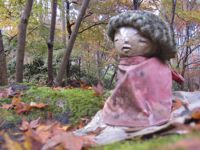
I first became aware of Japan as a unique culture due to the The Great Hanshin (or Kobe) Earthquake of January 1995, when I was 14. My home had a subscription to Time Magazine and for days I leafed through the pages, mesmerized by the destruction. But soon, I also became fascinated by the stories of how the Japanese dealt with their suffering. The casualties were still being tallied when a couple months later, the Aum Shinrikyo Cult released Sarin Nerve Agent on the Tokyo Metro. 1995 quickly shaped up to be the most tragic year for Japan since the Second World War. That is, until 2011.
On March 11th of last year I was enjoying an opportunity to sleep in when a friend's text -- "You watching the news about the Earthquake in Japan?!" -- woke me up. I leapt out of bed and turned on my laptop. The first picture I saw was an image of burning homes floating on seawater. My wife was now awake, and I told her that we were looking at Japan. A few keystrokes later we learned that, no, the affected region was not near her hometown. But as the disaster unfolded, there was little else to feel good about.

On any seaside walk in innumerable Japanese cities and towns one will come across tsunami warnings; the old carved into stone tablets, the new animations on placards. Natural disasters and the process of destruction and renewal are deeply ingrained elements of Japanese Culture. Related to this is an emphasis on transience, which is shown in the Japanese love of Sakura (cherry blossoms), Hanabi (fireworks) and the focus on adolescence in storytelling. An overwhelmingly coastal population living in an earthquake-prone region also understands that regardless of the plans one makes, circumstances can intervene and sweep them away. In this sense, the destruction of the Second World War actually fit into the existing cultural narrative, though on an unprecedented scale.
After the Kobe Earthquake, I developed a taste for Japanese films and other cultural exports. Eventually, due to friendships I had made and a buddy returning from Iraq who was up for anything, I decided to go visit. July of 2005 was the first of four trips that concluded with my wife and I welcoming our daughter into the world this past summer in her Wakayama Prefecture hometown. I'm not sure my life would have taken this route if not for the reporting of 1995.
Once again, a natural disaster has brought Japanese culture to the forefront of Western consciousness. And we mostly admire what we see: the stoicism of the population, the lack of anarchy and the courtesy to others demonstrated by the refuges in overcrowded shelters. But when the water receded, we also saw cracks in the system. The response efforts were challenged by the needs of elderly victims, leading to increased reporting on Japan's rapidly aging population, its low birthrate and increasingly low marriage rate. Then there was talk of the persistently stagnant economy and political infighting hampering swift delivery of resources to the affected populations. And later we saw that, yes indeed, Tokyo was less than forthcoming about the nuclear disaster at Fukushima.
After my first trip, I fell for Japan pretty hard. Exploring the culture and language was, for me, literally discovering a new world. But the process of love is always the same. At first everything about the object of desire is fantastic and fascinating. Then, inevitably, the focus you place on it//him/her reveals the flaws as well. But if the feeling is real it survives, albeit in a more adult
form.
The basic decency that guides Japanese Conduct never fails to impress me, but when I read about how The Tokyo Electric Power Company (TEPCO) disregarded a 2007 report suggesting that their tsunami preparations were woefully inadequate, I feel like I am reading a manga comic parody of recent American mistakes. These failings of the Japanese system cannot be removed from aspects of the Japanese culture. But there is also a renewed appreciation in the country for the positive characteristics that have proved so essential in dealing with this tragedy.
In the landmark Hayao Miyazaki anime My Neighbor Totoro a father and his two young girls move to the post-war countryside to be close to the mother who is staying at a local hospital. The familiar theme is the passage from childhood to adulthood, but a subtler message is also there. When this film was produced in 1988, much of the countryside in Japan had already been paved over by the post-war construction boom. The film asks its audience to remember what it has, to not let it slip away. Japan's problems have been laid bare by the Great Tōhoku Earthquake and Tsunami, but the Japanese have also been inspired with a new sense of pride for their way of life. And for Westerners who are interested in learning about or traveling to Japan, there has never been a better time.